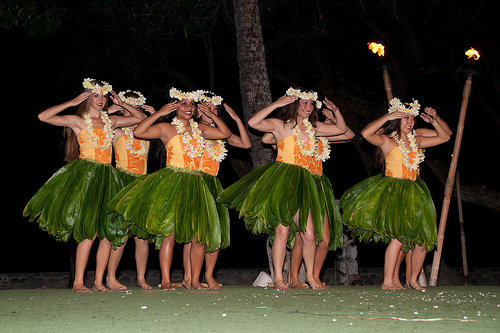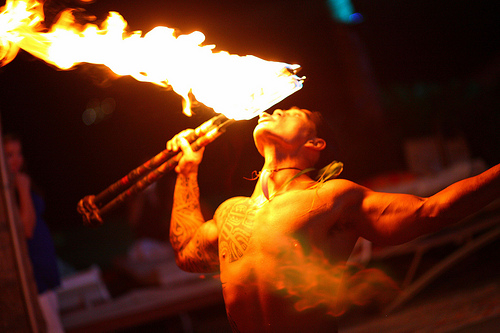The traditional Hawaiian feast now known as the luau dates back hundreds of years. Before the reign the Hawaiian King Kamehameha II, men and women in Hawaii were not allowed to eat together. After abolishing this law in 1819, he held a symbolic feast with women invited. At this feast, King Kamehameha served a traditional dish involving chicken wrapped in Taro leaves and baked in coconut milk. This dish, known as ‘Luau,’ gave this feast its name.
Rather than simply a party, luaus were held in recognition of important events, from notable visitors to a coming of age celebration. During the first luau dinners, diners sat on the ground and ate food placed on leaves and woven mats. Traditional foods for these early luaus included roast pig and mashed taro root (a staple of the Hawaiian diet), both of which are still served at many luaus today. In these days, women in Hawaii were forbidden from eating certain foods, considered delicacies. King Kamehameha II was sure to incorporate these into his symbolic feast. All of these foods were eaten with the fingers; no utensils were used.
While it was certainly a festive occasion, these luaus were only held for certain events, not solely for entertainment value. These luaus were a very specific type of celebration; they were not just any Hawaiian party. Luaus, both then and now, have always been large feasts. In fact, King Kamehameha II often invited hundreds of guests; sometimes, guests ate in several shifts because there was not enough room for everyone.
Today, luau parties are held all over the islands, both for tourists and for celebratory reasons. Guests at luaus receive a lei, a necklace of woven flowers, as a symbol of welcoming. Though many visitors to Hawaii visit large commercial luaus, they are still held throughout the island for more symbolic occasions.
Commercial luau parties held just for tourists are held weekly at the most popular hotels in Hawaii. These professional luaus are not only feasts, but also entertaining displays. Often visitors at a luau will see thrilling fire dances, which are actually Samoan rather than Hawaiian in origin, in addition to traditional Hawaiian hula dancers. If you are visiting Hawaii on vacation, be sure to visit a luau, not only for its delicious food but also for the entertainment. Often, crafts and souvenirs are sold in addition to more traditional foods and entertainment. Many tourist-centered luaus offer the opportunity for guests to learn a simple hula dance from traditional dancers.
Today’s luau parties are actually a fusion of cultures, including Asian, Polynesian, and Hawaiian influences in addition to mainland dishes served with tropical flair. Today, teriyaki sauce is a staple flavor in luau foods, giving each dish a sweet yet savory flavor. You may even see teriyaki sauce marinated Spam, a canned meat that is quite popular in Hawaii, in addition to more traditional Hawaiian dishes like poi and Kalua Pork. Luau parties were quite popular during the 1960s, so some luaus incorporate cocktail foods from this era, even macaroni salad, or cocktail weenies in teriyaki sauce. Today’s luau parties may simply be Hawaiian themed, and range drastically in their adherence to traditional luau foods and customs.


